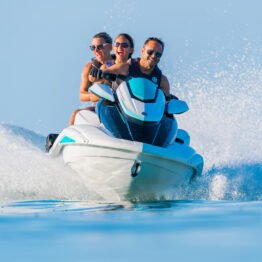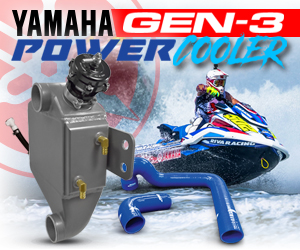
Stand up personal watercraft are incredibly fun and rewarding to ride, but the learning curve is so steep that many people give up before being able to stand and ride. After I bought my first stand up in 2015 I scoured the Internet for hints and tips on how to ride one, but came up empty handed. Now that I have a few years behind the bars of a number of stand ups, I’m bringing you my own how-to guide for learning how to ride these rewarding machines!
The Basics
The two main differences that separate the stand up from a sit down personal watercraft are the movable handle pole and the lack of a seat. The rider stands in the tray and the pole mounted handlebars move with the rider. Sounds simple right?

Parts of a Ski
There are a few pieces of a stand up ski outside of the main hull, handle pole, engine and pump that are important to note when learning to ride:
- Start/stop switch – the control on the left handlebar with a green start button and a red kill switch that you clip your lanyard into. If you fall off the ski, the lanyard that is attached to your body will come out causing the engine to die.
- Throttle lever – a lever found on the front of the right handlebar. Modern stand ups use a finger throttle where your index finger controls the pull of the lever. Pulling the lever toward you opens up the throttle. Some older skis have a thumb throttle on the back side similar to ATVs.
- Steering plate – how your steering inputs are connected to the ski. Handlebars mount directly to the plate, which is mounted to the handle pole.
- Steering Nozzle – directs the flow of water from the pump to push the stand up forward and turn.
- Intake grate – a scoop found on the bottom of the hull mounted to the pump tunnel that feeds water into the pump. Some stock skis do not use a scoop, but rather straight bars that keep debris from getting into the pump. Different scoop styles allow for more braking and better pump efficiency in choppy water.
- Ride plate/pump cover – a plate mounted below the pump itself that can extend beyond the hull for stability. Most stock ride plates are flush with the hull. Changing these out can increase stability and turning grip.

Getting Moving
The big question on everyone’s mind is, “how do you get moving on one of these skis?”
Each person has their own method that works best, but if you have never tried or nothing is working for you then keep reading!
Shallow Water Start
Best to stand in water that is about knee/thigh height and already have your lanyard in the kill switch. With one hand on the start switch and the other on the throttle, place a knee in the tray with your other leg behind the ski out of the way of the jet blast. Start the ski and moderately accelerate. While doing this kick off with the other leg and bring your knees together in the tray. If you have difficulty bringing both knees together, you can let one leg trail in the water as stabilization. Moderate speed helps with the side to side wobbling that plagues many beginners, including myself, but not so fast that you feel out of control and fly off.
Take your time to ride around on your knees to get the feel of the ski. Keeping your center of gravity lower makes it easier to correct mistakes and balance side to side motion. Once you are ready to stand I find it easiest to bring one leg forward, place that foot in the front of the tray and rise with your rear foot at the back of the tray. This method automatically puts you in the ‘surf stance’ riding position that gives you the most control over the stand up.

Deep Water Start
If a shallow start area is not available you can try two methods for deep water starts – pushing the back of the tray down or body dragging.
Tray Push – With your lanyard in the kill switch and your upper body in the tray, push the back of the ski into the water and place your knee(s) into the tray. Follow the steps above to get moving. This method takes some initial balance while the ski is stationary.
Body Drag – Make sure your lanyard is in the kill switch with your upper body in the tray, reach forward with both arms to place your hands on the controls to get the ski started. Your body will still be in the water behind the ski so you have to be careful of the jet blast. Once you are moving fast enough use the handlebars to pull your body forward into the tray in a push-up-like motion.
Turning
Now that you can get the ski moving and stand, it is time to try turning. As with most other tasks on a stand up ski, turning is a balancing act between the rider, gravity and the water’s drag. To start a left turn place your left foot in the front left corner of the tray and your right foot in the right rear part of the tray. Turn the handlebars to the left while simultaneously adding a bit of throttle. Adding some throttle overcomes the extra drag of the hull and bond rail dipping into the water. It helps to crouch lower if you have issues with wobbling side to side. For a right turn the right foot needs to lead in the front right corner with your left foot in the left rear area of the tray.
Pro tips: if you are turning the ski and falling to the inside of the turn (low side) while it feels like the jet ski is still going straight, try adding more steering angle for a tighter turn and a bit more throttle to stabilize the ski. On the other hand if you are falling to the outside of the turn (high side), crouch lower in the tray and try less steering angle and less throttle so you stop flying out of the tray. When switching feet, it helps to place both feet at the back of the tray to orient yourself.

Advanced Turning Techniques
Once you get the hang of turning you can practice some techniques to increase corner speed and stability. It is best to have a buoy or some other marker in the water for a fixed point to practice turning. These techniques very much depends on the ski and riding style, but for most modern skis this is a good starting point. As you initiate the turn shift your body weight slightly forward on your front leg to set the front end of the ski. Keep low, lean your upper body and core out of the tray to the inside of the turn. Add throttle as you apex the corner. Shift your body weight on to your rear leg to weight the pump for increased traction. Bring the ski upright and start the next turn. If you have difficulty increasing your corner speed, always get your body lower! There are many different tray sizes and hull designs so feel out what body positions work for you on the particular ski you are riding. Smaller stand ups require less rider input, while wider and longer skis need more steering and body lean to turn.
The Sky is the Limit
The greatest thing about stand up personal watercraft is that the opportunities to have fun are endless! From lake cruising and ocean wave riding to competitive freestyle back flipping and 60+ mph racing – stand ups can be customized to fit your adrenaline needs. Don’t sit down and let stand ups pass you by!























[…] first article published today – Back to Basics: How to Ride a Stand Up along with Part 1 of my tutorial video series. Give it a look and share with all of your […]
Great article!
One thing I found that helps new or younger riders. Tell them to ride around on knees until you get bored. When you feel like standing leave pole in the full down position. Stand up in back of tray with pole still down. Then ride around standing with pole down until you get your balance. Once you feel balanced and in control lift pole and stand upright.
I just got a new rider up in 20 minutes using this method.